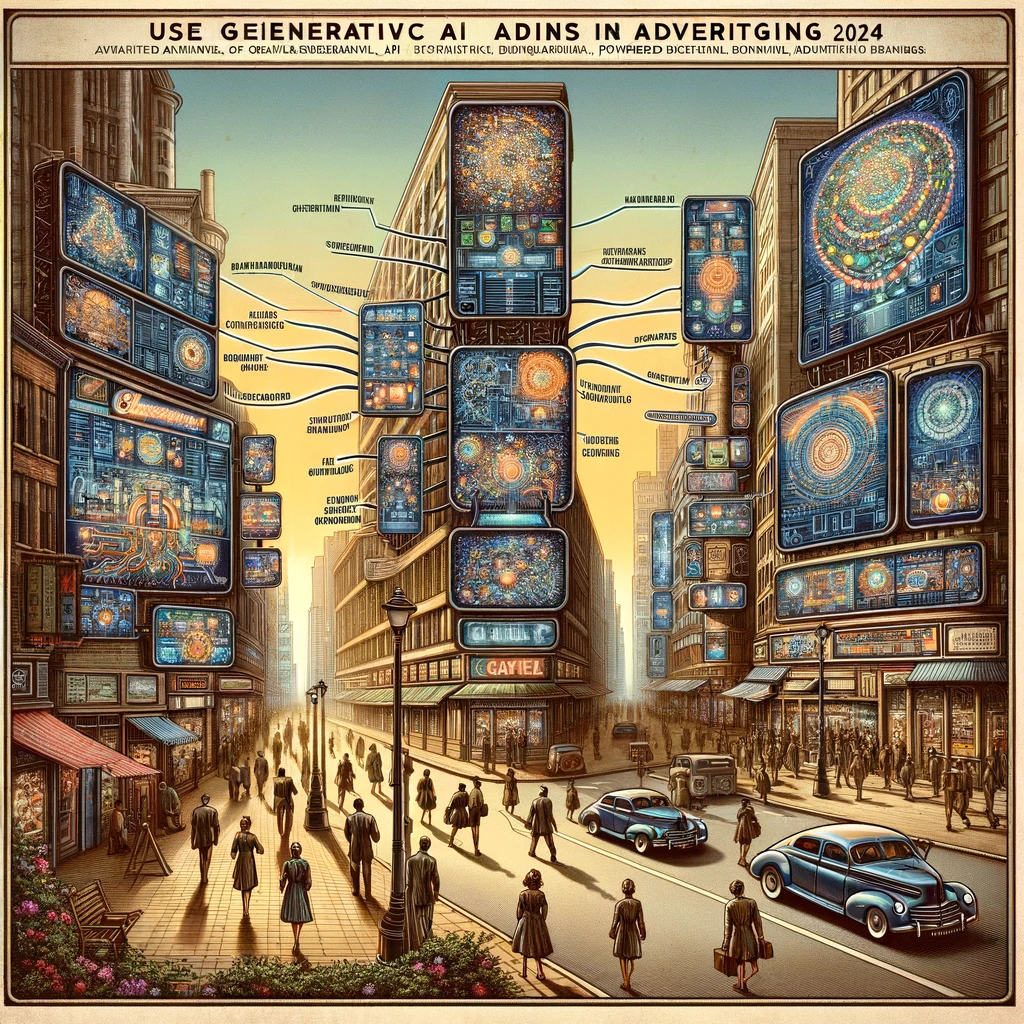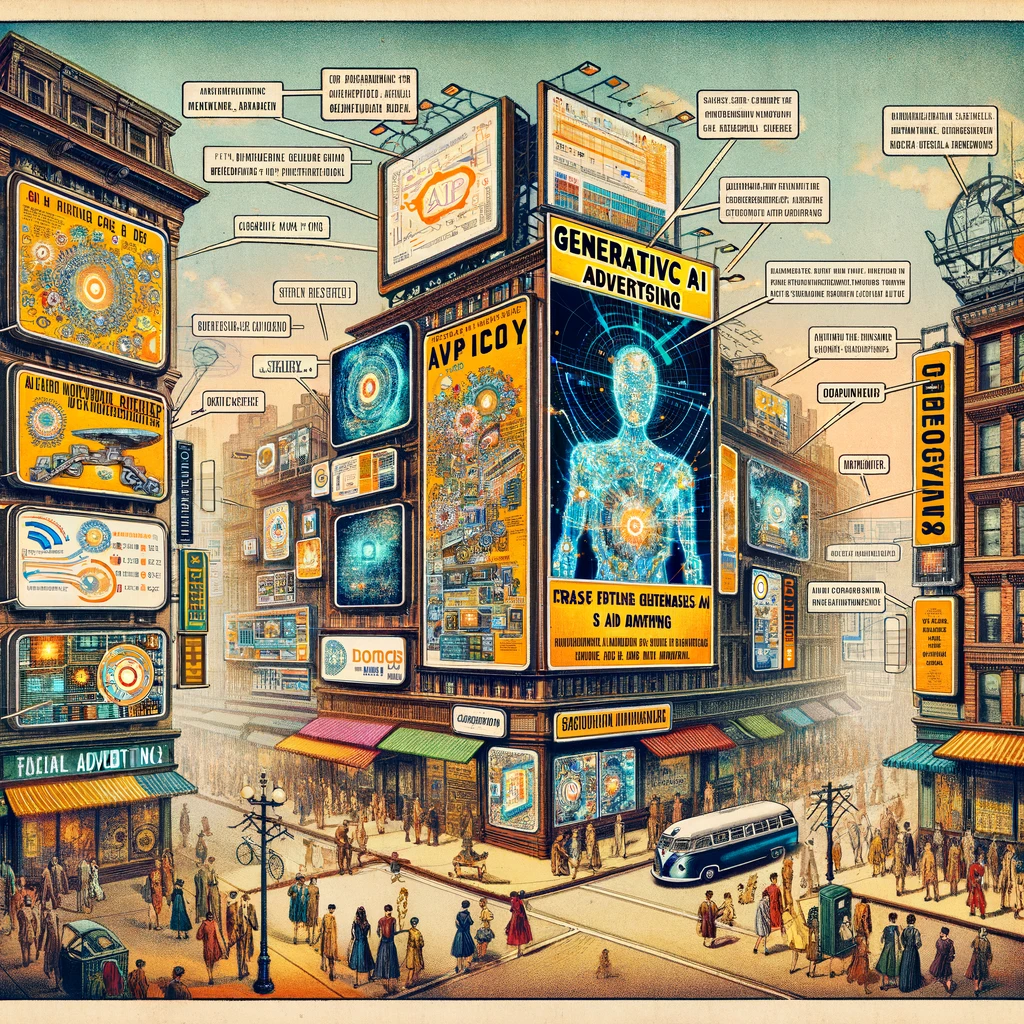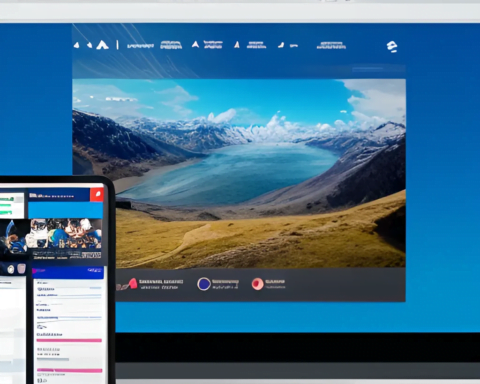Last Updated on March 7, 2024 10:18 am by Laszlo Szabo / NowadAIs | Published on March 7, 2024 by Laszlo Szabo / NowadAIs
AI in Advertising: Generative AI-Powered Ads & Advertising in 2024 – Key Notes:
- AI is significantly impacting the advertising industry by enhancing efficiency, creativity, and personalization.
- Generative AI is being embraced by marketing leaders, with a potential annual economic impact of $4.4 trillion globally.
- AI-powered tools like chatbots and recommendation engines are improving customer experiences and engagement.
- Ethical considerations, including data privacy and bias, are critical in the integration of AI into advertising.
Generative AI Advertising in Ad Industry – Introduction
In an era where the pace of innovation accelerates relentlessly, the realm of advertising is witnessing a transformative shift, thanks to the infusion of AI technology.
With forecasts suggesting that 88% of marketing leaders will have embraced Generative Artificial Intelligence by 2024, the potential growth this could inject into the global economy is staggering—an estimated $4.4 trillion annually, with the marketing and advertising industry alone reaping an additional $400-$500 billion in value.

Stay on Top with AI News!
Follow our Google News page!
The impact of generative AI on advertising is clear: as ‘content creation centaurs’—teams that combine human ingenuity with AI prowess—emerge, they revolutionize productivity and creativity in marketing spaces, from New York Times’ featured narratives to the e-commerce recommendation engines that subtly influence consumer choices.
As advertising strategies become intricately intertwined with AI and machine learning, the need for a robust, unified data strategy emerges as crucial to unlocking the full potential of AI in advertising spheres.
While Adobe Firefly exemplifies personalized content creation, raising the bar on customer engagement, concerns around privacy, data governance, and ethical advertising ai laws remain paramount. Nonetheless, the integration of such AI advertising technology is no longer just an option but a necessity for companies aiming to stay afloat in the competitive waters of digital advertising, customer experience, and beyond.
The article will delve into these facets, outlining not just the transformative power of AI in advertising but also the ethical and practical challenges that lie ahead.
The Evolution of AI-Powered Advertising
The evolution of Artificial Intelligence in advertising has been a journey marked by interesting milestones, each contributing to the sophisticated systems we see today:
- 1950s-1960s: The Foundations of AI in Marketing
- During the mid-20th century, the advertising industry began to leverage data analysis and customer segmentation. This period laid the groundwork for AI’s role in understanding consumer behavior and targeting advertisements more effectively. For more on the history, see the detailed exploration by Econsultancy.
- 1990s: The Rise of CRM Systems
- The introduction of Customer Relationship Management (CRM) systems and data mining techniques allowed for more effective analysis of customer data. These systems could sift through vast amounts of information to identify patterns and preferences, thus personalizing the customer experience.
- Early 2000s: Recommendation Engines Take Center Stage
- Amazon’s pioneering work with AI-powered recommendation engines marked a turning point. These engines became a cornerstone of personalized product suggestions, influencing the way consumers discovered products online.
- Late 2000s: Programmatic Advertising Changes the Game
- The advent of programmatic advertising automated the buying and selling of ad space, making the process more efficient and data-driven. This innovation represented a seismic shift in the marketing landscape.
- Modern AI-Driven Platforms
- Today’s AI-driven platforms are not only generating high-quality content but also analyzing and optimizing it for search engines. They enhance headlines, meta tags, and keyword density to improve SEO and visibility.
- Enhancing Customer Experience
- AI has significantly improved customer experience over the past decade, with chatbots and virtual assistants now capable of handling inquiries and processing transactions. These AI tools provide a level of interaction and responsiveness that was previously unattainable.
Looking ahead, the growth of AI in advertising is projected to be exponential. By 2030, the market size of AI is expected to reach nearly two trillion U.S. dollars, illustrating the vast potential of AI technology in transforming the advertising industry. For a deeper dive into the future projections, check out this article on The Evolution of AI in Marketing.
These developments have not only reshaped how advertisers connect with their audiences but also how they strategize and implement their ad campaigns. The integration of AI has become a pivotal element in creating a personalized and efficient advertising experience that resonates with consumers.
Benefits of Artificial Intelligence for Advertisers

- Efficiency and Speed: AI-powered content creation tools are redefining efficiency and speed in the advertising world. They leverage data-driven insights to generate content swiftly, outpacing traditional methods which can be time-consuming. By analyzing customer data, AI can quickly produce personalized ads that are more likely to resonate with the audience. However, advertisers must be vigilant to ensure that the speed does not come at the cost of creativity or lead to potential misinterpretations.
- Personalization at Scale: The power of AI to analyze extensive customer data sets enables advertisers to predict customer needs and preferences with remarkable accuracy. This level of personalization improves the customer experience by delivering content that feels tailor-made for each individual. For example, AI can learn from past consumer behavior to offer relevant recommendations, making every interaction with the brand feel unique and personal.
- Cost Optimization and ROI: By automating routine tasks, AI helps advertisers save time and optimize their ad spend. This automation extends to optimizing content for search engines, ensuring higher visibility and driving more traffic to websites. Predictive analytics further enhance ROI by allocating resources more effectively and identifying the most lucrative marketing channels and strategies.
- Real-Time Insights and Decision Making: Continuous data collection by AI tools means marketing teams can act on real-time insights, evaluating the impact of their decisions instantly. This leads to more informed decision-making and the ability to adapt strategies dynamically in a constantly evolving market. AI’s predictive capabilities mean that customer behavior is no longer a mystery; advertisers can identify prospects most likely to engage, enhancing the precision of targeted campaigns.
- Enhanced Customer Relationship Management: In customer relationship management provides invaluable real-time insights into customer interactions across various platforms. AI allows for a more cohesive and responsive approach to customer service, ensuring that the brand is present and attentive across all touchpoints.
Incorporating AI into advertising strategies is not just about embracing new technology; it’s about reimagining the possibilities of marketing. AI’s role in advertising is expansive, from content creation to campaign analysis, offering advertisers an unprecedented opportunity to connect with their customers in meaningful ways.
As we move closer to 2024, the integration of AI in advertising is set to become more pronounced, with 88% of marketing leaders expected to have embraced generative AI, marking a new chapter in the evolution of digital advertising.
AI’s Role in Marketing and Personalized Advertising
- AI-Enhanced Content Creation: AI-powered content creation tools are revolutionizing the way advertisers develop and distribute content. They are capable of generating new ideas, repurposing posts, and rewriting copy to suit different audiences. By analyzing audience engagement data, these tools can suggest relevant topics and create personalized content experiences that resonate with users. This level of customization ensures that content is not only relevant but also timely and engaging for the target audience.
- Personalized Video Experiences: An innovative approach to personalized advertising has been demonstrated by Carvana, which utilized advanced machine learning technology and AI to create personalized videos for customers. This technique showcases the potential of AI to provide unique and memorable customer experiences that can significantly enhance brand loyalty and customer satisfaction.
- Predictive Analytics in Targeting: The application of predictive analytics in marketing allows for predictive targeting, which fine-tunes advertising efforts to meet the specific needs of different segments. By predicting which tweaks will yield the best results for each advertising push, brands can more effectively allocate their resources and capture their audience’s attention.
- Navigating the Cookie-less Future: As the industry adapts to the deprecation of third-party cookies, generative AI offers alternative methods for targeting and tracking. By analyzing consumers’ digital behavior, AI provides new ways to reach audiences with precision, ensuring that advertising remains effective even as privacy concerns reshape the digital landscape.
- Hyper-Personalization at Scale: AI-generated content, including text, images, and audio, is becoming increasingly prevalent in marketing campaigns. This technology enables the creation of hyper-personalized content at a scale previously unattainable, allowing for highly individualized marketing that can lead to improved conversion rates and customer loyalty.
- Customer Data Analysis and Segmentation: By delving into customer data, AI helps in segmenting audiences and providing tailored messaging and offers. This deep analysis leads to a more profound understanding of customer preferences and behaviors, enabling advertisers to craft messages that are more likely to convert.
- AI-Powered Customer Interaction: AI-powered chatbots and virtual assistants are taking proactive customer service to the next level. They can anticipate inquiries or issues, providing timely and relevant assistance that enhances the overall customer experience and supports the customer journey from awareness to purchase.
- Real-Time Campaign Optimization: AI algorithms are instrumental in optimizing advertising campaigns in real time. They adjust bidding strategies, audience targeting, and ad placements based on performance metrics and customer feedback, ensuring that campaigns are continuously refined for maximum impact and efficiency.
By harnessing the power of AI in advertising, brands can create more personalized, efficient, and effective campaigns that not only meet but exceed customer expectations. The key to success lies in defining clear goals and choosing the right AI tools and algorithms to drive personalized advertising strategies that captivate and engage audiences.
AI-Powered Content Creation – Best Tools to Automate & Optimize Performance
In the dynamic landscape of ai in advertising, AI-powered content creation is making waves with tools designed to enhance efficiency and engagement:
- Social Media Mastery: Hootsuite’s OwlyWriter AI exemplifies the innovation in AI content creation, swiftly generating social media post captions that captivate audiences. This tool, along with others like ChatGPT and JasperAI, empowers brands to boost user engagement and click-through rates, elevating brand perception in the digital realm. For instance, Grammarly and Adobe Sensei are utilizing these advancements to create compelling social media content that resonates with their users.
- Diverse Content Formats: AI’s role in content creation extends beyond text, embracing audio and video formats to cater to various consumer preferences. Tools like Podcastle and Synthesia are at the forefront of this trend, using Natural Language Processing (NLP) and Natural Language Generation (NLG) models to produce content that closely mimics human language. This technology enables marketers to craft diverse content strategies that include blog articles, personalized marketing email campaigns, and even AI presentations.
- Strategic Content Insights: AI tools are not just content creators but also strategic advisors. By analyzing online content coverage, they provide actionable insights for content strategy, guiding what to write and how to write it. For example, HubSpot and MarketMuse leverage AI to dissect vast amounts of data, offering recommendations that align with current trends and audience interests.
AI Advertising Examples
The impact of AI on advertising is further underscored by innovative campaigns from leading brands:
- Coca-Cola’s Creative Fusion: In a groundbreaking campaign named “Masterpiece,” Coca-Cola partnered with OpenAI to blend human creativity with generative AI, setting a new standard in advertising.
- Cadbury’s Cost-Effective Stardom: Cadbury, in collaboration with Mondelez, tapped into OpenAI’s DALL-E 2 to craft an ad featuring Bollywood icon Shah Rukh Khan, achieving significant cost savings and demonstrating the economic efficiency of AI in advertising.
- Virgin Voyages’ Celebrity Innovation: In a bold move, Virgin Voyages launched a campaign featuring Jennifer Lopez, who became the first celebrity to “lend her likeness to an AI program,” showcasing the limitless possibilities of AI in enhancing brand narratives.
These examples highlight the transformative power of AI in crafting advertising strategies that are not only innovative but also cost-effective and deeply personalized. As the industry evolves, AI-powered content creation stands as a pillar of modern advertising, shaping the future of brand-consumer interactions.
Using AI in Advertising for Predictive Analytics and Consumer Insights
Predictive analytics in the realm of Artificial Intelligence in advertising leverages historical data to forecast future marketing trends and consumer behaviors, enabling advertisers to craft strategies that resonate more effectively with their target audience. Here’s how predictive analytics is transforming the advertising landscape:
- Understanding and Anticipating Market Trends:
- Past to Future: Utilizes past consumer data to predict future market trends, evolving from traditional media mix modeling (MMM) to more sophisticated multi-touch attribution (MTA) techniques.
- Strategic Planning: Enables advertisers to plan their campaigns with foresight, staying ahead in the competitive market by anticipating shifts in consumer behavior and preferences.
- Tools and Software: Requires advanced marketing analytics software to distill vast amounts of data into actionable insights, helping marketers make decisions regarding media planning and buying (Role of Predictive Analytics in Customer Acquisition).
- Models and Techniques in Predictive Analytics:
- Cluster Analysis: Groups consumers based on similar behaviors or preferences, allowing for targeted advertising strategies.
- Propensity Models: Predicts the likelihood of a consumer’s future action based on past behavior, enhancing the effectiveness of marketing campaigns.
- Recommendations Filtering: Provides personalized product or content recommendations to users, improving customer engagement and satisfaction.
- Impact and Use Cases:
- Forecasting Consumer Trends: Identifies and forecasts emerging consumer trends, enabling the development of profitable advertising programs.
- Enhancing Customer Acquisition: Classifies potential viewers and customers, streamlining the process of obtaining new customers and improving predictive lead scoring.
- AI’s Expanding Role: With the market for predictive analytics expected to reach $28 billion by 2027, AI’s role in forecasting future customer behaviors and trends is becoming increasingly crucial.
Predictive analytics, powered by AI technology, is not just a tool for anticipating market trends; it’s a strategic asset that empowers advertisers to create more personalized, efficient, and impactful advertising campaigns. By harnessing the power of predictive analytics, advertisers can navigate the complexities of the digital advertising landscape with greater precision and foresight.
Challenges and Ethical Considerations
Incorporating AI into advertising workflows brings forth a spectrum of ethical considerations that must be diligently addressed to ensure the responsible use of technology. Among these, bias and discrimination, privacy and data protection, and accountability and transparency stand out as critical areas of concern.
- Bias and Discrimination:
- AI systems are only as unbiased as the data they are trained on, highlighting the importance of using diverse datasets to prevent AI from perpetuating existing biases.
- Marketers need to avoid using biased datasets and ensure that the AI algorithm produces fair and unbiased content, a step critical for maintaining the integrity and inclusivity of AI-generated content.
- Regular monitoring and audits of the AI algorithm must be done to ensure that there is no perpetuation of bias and discrimination, safeguarding against negative stereotypes and bias in AI-generated content.
- Privacy and Data Protection:
- Companies must ensure that their AI applications comply with applicable privacy and data protection regulations, a necessity in today’s data-driven world.
- Transparency about the data collected and adopting privacy by design principles are fundamental for building trust with consumers and adhering to legal standards.
- Brands are implementing best practices for collecting, storing, and analyzing data to protect customers and organizations from data privacy, protection, and security issues, showcasing a commitment to ethical data handling.
- Accountability and Transparency:
- Marketers and AI developers must be able to explain how the AI system arrived at its decisions, a requirement for ensuring accountability in AI applications.
- Taking responsibility for any negative impacts AI may have on individuals or society as a whole is essential for ethical AI use, as it fosters a culture of accountability and ethical responsibility.
- Addressing ethical concerns can help companies maintain a positive image and reputation, reinforcing the importance of ethical considerations in AI use.
By focusing on these ethical considerations, companies can navigate the complex landscape of AI in advertising with a conscientious approach that respects consumer rights and promotes fairness. For further insights into the ethical concerns of AI in marketing, readers can explore detailed discussions on ethical concerns of AI in marketing and how addressing these concerns is imperative for maintaining a positive brand image and reputation as elaborated in ethics of AI in content creation. Additionally, the necessity of diversifying input data to mitigate bias is thoroughly examined in the article on ethical considerations using AI in marketing, providing a comprehensive overview of the ethical landscape in AI-driven advertising.
Best Example of AI in Action
In a strategic move to harness the power of generative AI to create brand identity and advertising, Coca-Cola has appointed Pratik Thakar as the global head of GenAI. This decision underscores the beverage giant’s commitment to integrating cutting-edge AI technology into its marketing strategies, aiming to enhance creativity and personalization in advertising campaigns.
- Role of Pratik Thakar:
- Appointed as the global head of GenAI at Coca-Cola.
- Tasked with leveraging AI to innovate brand identity and advertising strategies.
- Objective:
- To infuse AI technology into Coca-Cola’s marketing efforts.
- Enhance advertising creativity and personalization at scale.
- Expected Outcomes:
- Increased engagement and resonance with target audiences.
- Elevated brand identity through AI-powered advertising content.
Coca-Cola’s initiative to embrace AI in advertising is a testament to the industry’s shift towards more technologically driven marketing approaches.
By prioritizing AI, Coca-Cola aims to set new standards in how brands interact with consumers, making every advertising effort more relevant, engaging, and impactful.
The Future of AI in Marketing and Advertising
- Global AI Standards and Policy Focus: The Consumer Electronics Show (CES) 2024 emphasized the importance of AI in media and marketing, sparking discussions on AI policy, ethical considerations, and the impact on diverse-owned media. The expected establishment of global AI standards, although compliance may vary, signifies a unified approach towards managing AI advancements and their applications in advertising.
- Technological Leadership and Market Dynamics:
- OpenAI and Microsoft Co-Pilot: Positioned to spearhead AI advancements with significant implications for enterprise AI solutions, impacting the ai in advertising landscape.
- Google’s Anticipated Decline: A shift in the digital ecosystem is expected as Google’s dominance may wane due to its slow evolution in search offerings and smart home devices, suggesting a more competitive market for AI-driven advertising solutions.
- AI-Driven Innovations and Industry Transformations:
- Cost and Efficiency: Predictions indicate a decrease in AI costs, potentially revolutionizing ai advertising by making advanced AI tools more accessible to marketers, although savings may not be immediately passed on to consumers.
- Content and Experience Personalization: AI is set to transform the entertainment and music industries with custom-generated, themed experiences and AI influencers targeting younger generations, showcasing the broad applicability of AI in creating personalized consumer experiences.
- Healthcare and Marketing Synergy: Personalized medical care enhanced by AI highlights the cross-industry potential of AI, suggesting similar personalized approaches could revolutionize customer service and engagement in advertising.
- Generative AI and Marketing Transformation:
- Creative Ideation and Efficiency: The rapid adoption of Generative AI is driven by its potential to streamline the creative process, making ad copy development and personalization more dynamic and efficient.
- Market Optimism and Strategy Shifts: With 67% of marketers optimistic about the potential of Generative AI in advertising, a significant transformation in marketing strategies is anticipated, focusing on leveraging AI for enhanced creativity, efficiency, and personalization.
- Data Strategy and Privacy: The era of generative AI necessitates a unified data strategy, with advertisers adopting technologies like data clean rooms to leverage subscriber data while respecting privacy and content licensing requirements, indicating an evolving approach to data management and utilization in advertising.
This evolving landscape underscores the transformative role of AI in advertising, from enhancing creative processes to introducing new levels of personalization and efficiency across various industries. As we move towards 2024, the integration of AI in advertising strategies is expected to become more pronounced, setting the stage for a new era of digital marketing dominated by AI-driven innovations and solutions.
Conclusion
As the digital horizon expands, the infusion of generative AI into advertising heralds a future where personalized, efficient, and innovative ad campaigns become the standard, rather than the exception. The evolution from traditional advertising methods to AI-powered strategies underscores a pivotal shift in how brands connect with consumers, offering tailored experiences that resonate on a personal level. This journey through the development, application, and ethical considerations of AI in advertising reveals the boundless potential and challenges that lie ahead, setting the stage for transformative change in the industry.
Looking forward, the commitment of industry leaders to embrace AI, as demonstrated by initiatives like Coca-Cola’s appointment of a global head of GenAI, signals a robust trajectory towards more engaging and impactful advertising landscapes.
As we navigate the complexities of this rapidly evolving domain, the importance of ethical considerations, creativity, and personalization in AI-driven campaigns cannot be overstressed.
To explore how AI is reshaping advertising and marketing strategies, delve deeper into the insights and future projections shared by experts in the field.
Definitions
- Artificial Intelligence: Technology that simulates human intelligence processes through machines, enabling them to perform tasks that typically require human intellect.
- Machine Learning: A subset of AI that uses algorithms to analyze data, learn from it, and make informed decisions or predictions.
- Customer Relationship Management (CRM): Strategies and technologies used by companies to manage and analyze customer interactions and data throughout the customer lifecycle.
- Recommendation Engines: AI systems that suggest products, services, or content to users based on analysis of data.
- Programmatic Advertising: The automated buying and selling of online advertising space, utilizing algorithms to optimize ad placements in real time.
- Advertiser: An entity that promotes products or services through various forms of media to attract and engage customers.
Frequently Asked Questions
- How is AI transforming advertising?
Artificial Intelligence (AI) is revolutionizing the advertising industry by introducing a level of personalization and efficiency previously unattainable. It does so by analyzing vast amounts of data to understand consumer behavior and preferences at an individual level. This deep understanding enables the creation of highly targeted and personalized advertising campaigns that resonate with the audience, significantly increasing engagement rates and ROI. Moreover, AI streamlines the ad creation and placement process, automating tasks that were once time-consuming, thereby allowing marketers to focus on strategy and creative development. - What benefits does AI offer in advertising?
The integration of AI into advertising brings numerous benefits, including scalability of campaigns, the ability to deliver personalized customer experiences at scale, and a notable improvement in the return on investment (ROI) of advertising spends. AI’s ability to process and analyze data in real-time allows advertisers to optimize campaigns on the fly, ensuring that ads are shown to the right audience at the right time and in the right context. This not only increases the effectiveness of advertising campaigns but also enhances the overall customer experience by making ads more relevant and less intrusive. - Can AI in advertising improve customer engagement?
Absolutely. AI significantly enhances customer engagement by leveraging data insights to create advertisements that are highly relevant and personalized to each individual’s interests and behaviors. This personal touch makes ads more appealing and engaging to consumers, leading to higher interaction rates. Furthermore, AI can predict customer needs and preferences, enabling advertisers to present products or services at the optimal moment along the customer journey, thereby fostering deeper connections between brands and their audiences. - What challenges does AI face in advertising?
While AI offers transformative potential for advertising, it also faces several challenges. Key among these are ethical concerns related to data privacy and the potential for algorithmic bias. Ensuring that AI systems respect user privacy and comply with data protection regulations is paramount. Moreover, there’s a need to vigilantly monitor and correct biases in AI algorithms to prevent discriminatory practices. Overcoming these challenges requires continuous oversight, transparency in AI operations, and a commitment to ethical standards. - How will AI in advertising evolve?
The evolution of AI in advertising is poised to see even greater integration of AI technologies, with advancements in predictive analytics, machine learning, and natural language processing leading the way. These technologies will enable advertisers to anticipate consumer needs with greater accuracy, deliver even more personalized content, and measure campaign effectiveness in more sophisticated ways. Additionally, we can expect AI to unlock new creative possibilities in ad design, making use of generative AI to create dynamic and engaging content that adapts in real-time to the viewer’s preferences and context. The future of AI in advertising lies in its ability to create more meaningful and value-driven interactions between brands and consumers.
- How is AI transforming advertising?
Table of Contents
Toggle










